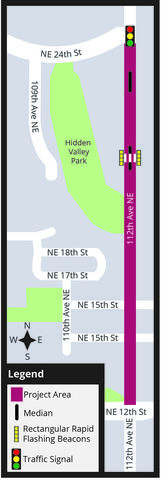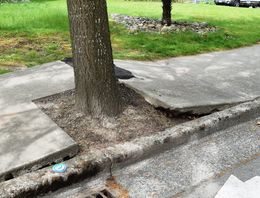
The 112th Avenue Northeast Corridor Improvements project, from Northeast 12th Street to Northeast 24th Street (map), will increase safety and accessibility for people who walk, roll, bicycle and drive. The work includes replacing sidewalk panels damaged by the roots of street trees, adding a new mid-block crossing, installing a new traffic signal, repaving the roadway and other improvements.
Benefits
- Replace sidewalk panels on both sides of the street where street trees have caused or could cause cracking and heaving; replace curb ramps to meet federal accessibility standards.
- For added safety and convenience, add a new mid-block crosswalk, median island and flashing beacon north of the entrance to Hidden Valley Sports Park, where an earlier mid-block crossing was installed in 2018.
- Install a new traffic signal at 112th Avenue Northeast and Northeast 24th Street to improve traffic flow.
- Repave the roadway to improve the pavement and extend its life.
- Add underground electrical conduits to support a future street lighting upgrade project when funding becomes available.
About the tree removal
Street trees are a valued part of Bellevue’s urban forest, providing aesthetic, environmental and economic benefits, plus wildlife habitat. On 112th Avenue Northeast, however, tree roots have caused sidewalk panels to buckle or heave, resulting in trip hazards for pedestrians. City staff have determined that for safety and accessibility reasons nearly 60 street trees along the sidewalk must be removed.
Unfortunately, there is insufficient space within the public right-of-way to replace the trees and make the sidewalk wide enough to meet today’s accessibility standards. The trees removed will be replaced with approximately 100 trees at nearby Hidden Valley Sports Park, in an area currently overgrown with blackberries and other invasive vegetation. For more information on the street trees, see the Frequently Asked Questions section below.
Schedule
- 2022 spring: Substantial completion
- 2021: Construction start
- 2020 (June): Project mailer sent
- 2019-2021: Project design work
- 2018: Completed separate but related pedestrian and bicycle improvements project
Funding
Primarily funded by the Neighborhood Safety, Connectivity and Congestion Levy, with support from other capital investment funding sources. Estimated construction cost is $2.5 million.
Outreach material
- Construction alert mailer (May 2021)
- Project update mailer (June 2020)
Frequently Asked Questions
Why are trees being removed?
Many of the oak trees planted along 112th Avenue Northeast, between Northeast 12th Street and Northeast 24th Street, have uprooted sidewalk panels on both sides of the road. Tree roots have caused sidewalk panels to become uneven and cracked, resulting in trip hazards for people walking and biking.
The oak trees were planted over 30 years ago and are well past the expected lifespan for a street tree. At the time, the only spaces available for street trees in this location were 3-foot by 3-foot tree pits cut into the sidewalk. Current tree planting practices consider this much too restrictive for tree roots and incompatible with sidewalks and utilities. Today, tree pits are avoided and where space is available continuous planters with more available soil are installed.
Why can’t new trees be planted in the same place?
Are trees located behind the sidewalk being removed?
No. Only trees within the sidewalk, next to the curb, are being removed.
What is tree mitigation?
Tree mitigation compensates for the removal of trees by planting a proportionate number of replacement trees. For this project, approximately 60 trees in the sidewalk along 112th Avenue Northeast must be removed. To mitigate the loss, 100 new trees will be planted at Hidden Valley Park. The location was chosen for maximum environment improvement. This degraded site is currently covered with invasive weeds. The new trees will be a mix of evergreen and deciduous trees, with an understory of native plants.
Will the tree removal lessen the city’s tree canopy?
No. The replanting of 100 trees at Hidden Valley Park will add to the overall tree canopy. Additionally, trees left standing behind the sidewalk are expected to flourish because they will no longer be competing with the street trees.

